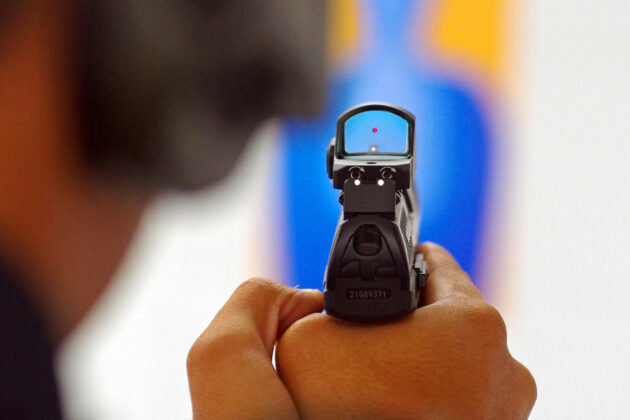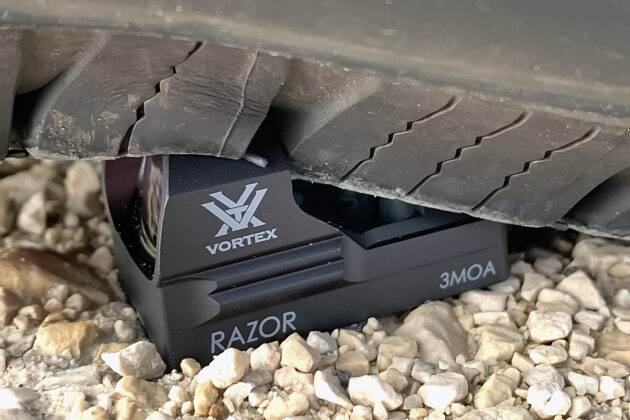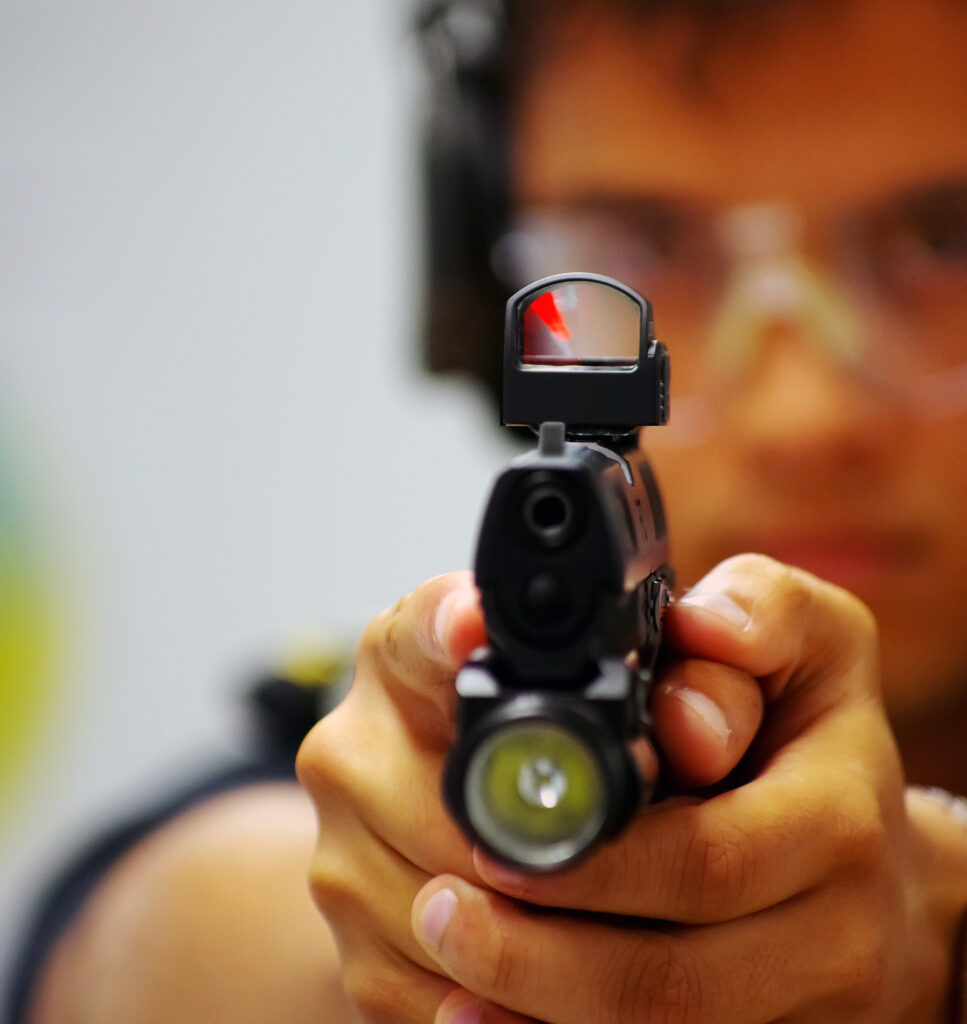
The future of police sidearms in Canada
We have come a long way since red dot sights were first popularized by competitive handgun shooters in the mid-1980s. Sights such as Aimpoint and Tasco ProPoint began to dominate action shooting and the unlimited classes of practical pistol shooting, when top competitors immediately saw the advantages of a fast sight picture, increased accuracy in multiple-shot scenarios and better situational awareness.
Early red dot sights were heavy and bulky, and battery life was measured in hours instead of years. In those days, we carried almost as many spare batteries in our range bag as we did spare magazines.
Today, with the increased usage of the patrol carbine by most armed agencies in Canada, officers are more familiar with the red dot sight and how well it works. The latest technology in micro red dot sights (MRDS) has now brought the electronic sight back home to the pistol where it first started decades ago. Within a few years, nearly every agency in North America may be equipping their duty sidearm with a MRDS, with all the benefits of greater accuracy and less hazard to the public.
Advantages of red dot sights
In a life-threatening situation where a pistol must be utilized, officers equipped with traditional sights use the same techniques today that were perfected over a century ago as shooters began to realize that shooting cowboy-style from the hip might win fast draw contests or look good in those new-fangled moving pictures, but made little sense in real life encounters where there’s no trophy for second place.
Firstly, the pistol must be presented toward the threat. If shooting is justified and the decision is made to fire, the officer must instantly reframe their focus off the threat and onto the front sight, align front and rear sight with each other and finally establish a steady sight picture on the target.
Achieving an accurate shot uses a combination of grip, stance, sight picture and trigger control, developed through many hours of training and many more hours of dry-fire practice, to create what is often called ‘muscle memory.’
Well, muscles don’t have memory. Muscle memory is another term for practicing basic techniques such as grip, stance, sight picture, trigger control, draw and reload, so that these actions become smooth and unconscious.

Photo credit: Dave Brown
It’s in this constant practice of the basics that takes the student of the pistol from the point where they are unconsciously untrained, through becoming consciously trained, finally culminating into the stage of unconsciously competent. It is these automatic reactions of the human body that can save lives. So-called muscle memory comes from the head; it is skills imprinted into the subconscious through constant repetition of the basics.
Initial training with red dots is no different than training with iron sights. The first few times, beginners will have trouble finding the dot and one can see their pistol track sideways and up and down as they hunt for the dot. Once they start to relax their early death grip on the pistol and learn the importance of a good support-hand grip, students adapt rapidly.
With live-fire training, broken up by extensive dry-fire practice, their presentation is more consistent, and the dot will be centered every time.
Today, with the increased usage of the patrol carbine by most armed agencies in Canada, officers are more familiar with the red dot sight and how well it works.
In transitional training with experienced officers, red dots have a steeper learning curve than traditional sights. With traditional sights, when the sight picture is off, officers can look at the sights and see which direction to move the handgun to align properly. With red dots, it’s hard to know where the dot is if it’s not visible.
Therefore, transitional pistol training concentrates back to the basics of grip, stance, sight picture and trigger control; all while using the major advantage of red dots—one’s eyes stay focused on the threat the entire time instead of shifting to the front sight.
This is why a traditional presentation style of draw from the holster up-and-out is combined with a focus that never leaves the threat. For this reason, officers adapt quicker if they watch the target first and then bring the dot to the target instead of trying to track it like they would a front sight through the last two stages of the draw sequence.
By maintaining target focus, the red dot also becomes easier to track under recoil, especially in dynamic situations where both shooter and target may be moving.
How fragile are electronic sights?
Due to the minimal parallax error of good red dot sights, the dot itself does not need to be centered in the sight window. In fact, tests have shown that the sight window can be almost completely shattered but if there is still a bit of glass remaining, it can be used accurately. With a proper target focus with both eyes open, the front of the window can also be completely blocked and the dot can still be used.
In an impressive display of the strength of the modern pistol-mounted red dot sight, Blue Line subjected samples of typical sights as provided by Vortex Optics Canada, through a round of torture tests. Sights were left in water for a week, dropped 10 times onto a concrete floor from a height of three meters and then, in a final round of tests designed to exceed anything that a sight might be expected to do, were used to pound nails through a board and finally driven over by a patrol SUV.

Vortex red dot torture test. Photo credit: Dave Brown
They all survived without a scratch. Not surprisingly, when mounted back on a pistol, they also held their zero perfectly.
Battery life has also evolved tremendously. With commonly-found button cells, the sight can stay on constantly and simply replaced every year during qualifications.
Astigmatism issues
An issue that will arise, especially with older officers, is astigmatism. This creates what is referred to as a ‘cluster of grapes’ effect. Instead of seeing a single dot in the sight window, some officers will see multiple dots. This is not a flaw in the sight. As the eye ages, it loses some of its perfectly round shape, and bright points of light can be viewed more like multiple points.
Blue Line investigated the issue of astigmatism and red dots sights in 2016, and while irritating, it’ll have little effect on accuracy with the pistol.
Transitional training programs
Target shooting is a perishable skill. Because it relies so much on the imprinting of the basic techniques into the subconscious mind, it must be practiced to become perfect. This is where transitional training programs will first bring even the most experienced officers back to relearn the basics through a combination of live-fire and dry-fire exercises.
The draw and presentation from the holster will be familiar. What will change is the need to center the eye behind the sight box and the need for a consistent presentation, especially during draws and reloads. Shooting from unusual positions, dynamic shooting scenarios and one-hand exercises will build confidence, but all these skills need to be founded on a good base, developed from good training right from day one.
Officers will also learn some of the mechanics of the red dot sight system, from mounting and zeroing to tracking the dot while moving and how well they work even if the sight is totally occluded.
Transitioning to the future
Micro red dot sights are not a magic solution to every deadly force encounter. They cannot think and they cannot evaluate dynamic situations for possible de-escalation alternatives. They may become commonplace on police duty sidearms in the next 10 years in Canada, but red dot sights do not replace good training that emphasizes practicing technical skills until they become automatic actions, allowing the officer to better see, think and evaluate in high stress situations.
We use the technology of red dot sights to expand the limitations of humans, but we still need humans to make up for the limitations of technology.
Pistol-mounted red dot sights have clear advantages for both officers and bystanders. They are fast to acquire; can be tracked easier, especially on moving targets; and the officer’s focus remains on the threat instead of on the front sight. For some officers, they are not that much faster to acquire than traditional sights – in fact, for the average beginner they may be fractions slower. But speed comes from the basics, mastered.
To paraphrase martial arts legend Bruce Lee, one should not fear the person who has practiced a thousand techniques once as much as one should fear the person who has practiced one technique a thousand times.
Dave Brown is Blue Line’s firearms and police vehicle contributor, as well as a Best Dressed Police Vehicle Awards judge. He is a tactical firearms trainer and consultant based in Winnipeg. He can be reached at Dave.Brown@northwestlaw.ca.
Print this page
 Photo credit: Dave Brown
Photo credit: Dave Brown